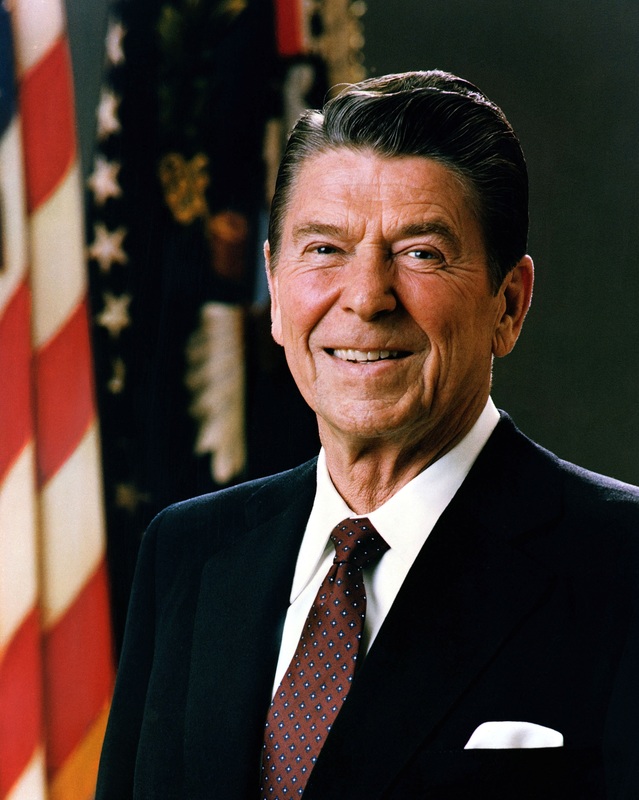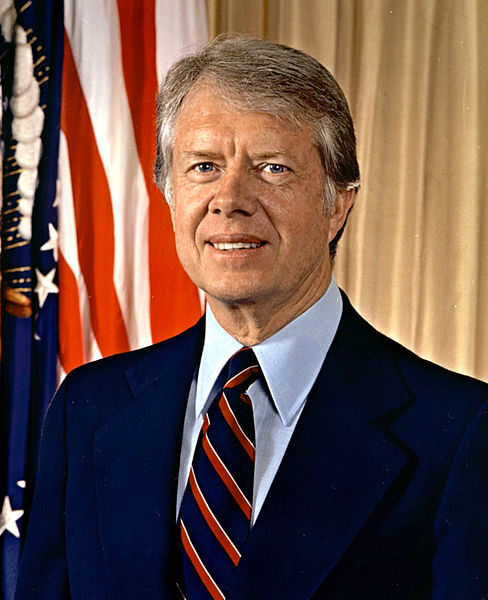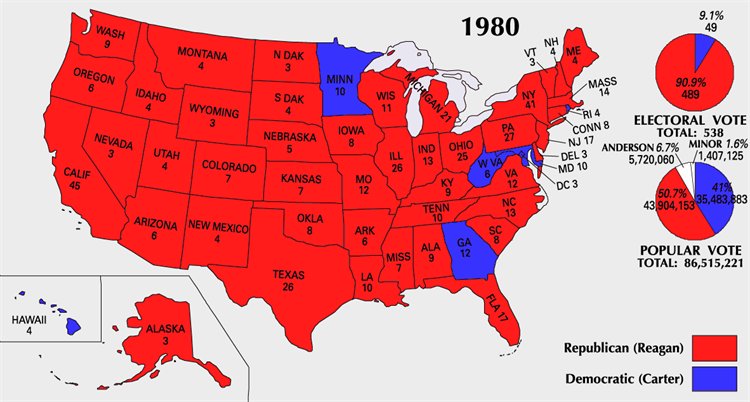Introduction
Despite the detente approach, the USSR continued to extend its influences in the South East Asia, Latin America, and the Middle East. On Christmas Day, 1979, the Soviets began what would become an eight-year occupation of Afghanistan, a mountainous country that was seen as the key to controlling travel between the oil-producing Middle East and Soviet Asia. 1979 was also the year that Iranian revolutionaries stormed the American embassy in Tehran and took fifty-two hostages. Against this backdrop, President Carter ran for reelection in 1980 against Republican Ronald Reagan, who had been a radio broadcaster, movie actor, President of the Screen Actors Guild, and Governor of California. Reagan was quick to point out the timely failures in Iran and Afghanistan as indicators that detente was a weak, dangerous, and outmoded policy that put American security at risk and allowed the Soviets to gain world-wide influence unchecked. The hostage crisis would remain unresolved as Americans went to the polls to vote in the 1980 election.
Despite the detente approach, the USSR continued to extend its influences in the South East Asia, Latin America, and the Middle East. On Christmas Day, 1979, the Soviets began what would become an eight-year occupation of Afghanistan, a mountainous country that was seen as the key to controlling travel between the oil-producing Middle East and Soviet Asia. 1979 was also the year that Iranian revolutionaries stormed the American embassy in Tehran and took fifty-two hostages. Against this backdrop, President Carter ran for reelection in 1980 against Republican Ronald Reagan, who had been a radio broadcaster, movie actor, President of the Screen Actors Guild, and Governor of California. Reagan was quick to point out the timely failures in Iran and Afghanistan as indicators that detente was a weak, dangerous, and outmoded policy that put American security at risk and allowed the Soviets to gain world-wide influence unchecked. The hostage crisis would remain unresolved as Americans went to the polls to vote in the 1980 election.
|
|
|
Campaign Video Prompts
Use your above responses and the electoral college map below to answer the following prompts.
- Create a T-Chart and track the "Mood" of both campaign ads.
- Create a T-Chart and track the "Tone" of both campaign ads.
- Summarize the message of each campaign ad.
- What was the most effective image/argument/phrase/word from each campaign ad?
Use your above responses and the electoral college map below to answer the following prompts.
- Who won the election? (What was the popular and electoral vote count for each candidate?)
- What geographic or regional patterns of electoral votes do you notice?
- What convincing aspects (or unconvincing aspects for the "also-ran") of the winner's ad could help explain their victory (and margin of victory) in that year's Electoral College?
Consulting Primary Source Texts
After completing your investigation and responses to the prompts about the 1980 presidential campaign, you will now examine two primary source documents from this era of Presidential Cold War era.
As you complete a close-read of the provided documents, you should:
Primary Source One: June 1982 Address to Parliament
Primary Source Two: March 1983 Speech
After completing your investigation and responses to the prompts about the 1980 presidential campaign, you will now examine two primary source documents from this era of Presidential Cold War era.
As you complete a close-read of the provided documents, you should:
- Compose a summary of each document in your own words
- Respond to the given prompts by citing at least two specific pieces of evidence from the text
- Compose a Venn diagram and short paragraph that compares and contrasts the mood, tone, and message of both the documents and the candidate's campaign ads
- Write a brief paragraph prediction as to the successes and/or failures of the president's actions or policies in this Cold War period.
Primary Source One: June 1982 Address to Parliament
Primary Source Two: March 1983 Speech
Consulting a Secondary Source
In consulting the campaign ads and primary sources from this Cold War presidency, you have only a small lens with which to evaluate their broader foreign policy accomplishments. Now you will review a secondary source treatment of President Reagan's first term foreign policy to assess:
Linked below is the official Office of the Historian summary of President Reagan's foreign policy. You may choose to find your own secondary source(s) in addition to this source. Review the document and answer the prompts that follow citing at least two pieces of evidence from a primary source.
President Reagan's Foreign Policy
Questions
In consulting the campaign ads and primary sources from this Cold War presidency, you have only a small lens with which to evaluate their broader foreign policy accomplishments. Now you will review a secondary source treatment of President Reagan's first term foreign policy to assess:
- the effectiveness of his actions, policies, and/or doctrines
- the ability of the president to live up to their stated campaign promises
Linked below is the official Office of the Historian summary of President Reagan's foreign policy. You may choose to find your own secondary source(s) in addition to this source. Review the document and answer the prompts that follow citing at least two pieces of evidence from a primary source.
President Reagan's Foreign Policy
Questions
- What foreign policy campaign promise(s) did President Reagan make in 1980? Did the primary sources or secondary sources provide evidence of keeping or breaking the promise(s)? Explain.
- How did the secondary source explain the success/failure of those policies?
Interact with History
As a final assessment of your investigations, choose one of the options below to complete and submit to the website as a comment or email (sean@juniorhistorians.com). Your project must contain at least four cited pieces of evidence from the sources provided.
As a final assessment of your investigations, choose one of the options below to complete and submit to the website as a comment or email (sean@juniorhistorians.com). Your project must contain at least four cited pieces of evidence from the sources provided.
- Create a rebuttal campaign ad for the "also-ran" that points out the failures or inaction of the winning president's foreign policy.
- Create a foreign policy briefing for the president that takes a historical event from one of the primary sources and argues for a different course of action. Be sure to explain the situation and justify your proposed changes.
- Create a Wordle analysis by pasting the text of each document (two separate Wordles) into Wordle.net/create. Then write a paragraph analysis of the word trends and usage that you observe for each text.
- Find another primary source document related to the president's Cold War foreign policy and submit a video of you completing a close read of that document.
- Create a multimedia presentation that compares and contrasts two additional campaign ad issues. Additional campaign ads can be found at livingroomcandidate.org.
- Take a stance and write your own biased secondary source historical review of the president's foreign policy accomplishments.



 RSS Feed
RSS Feed
